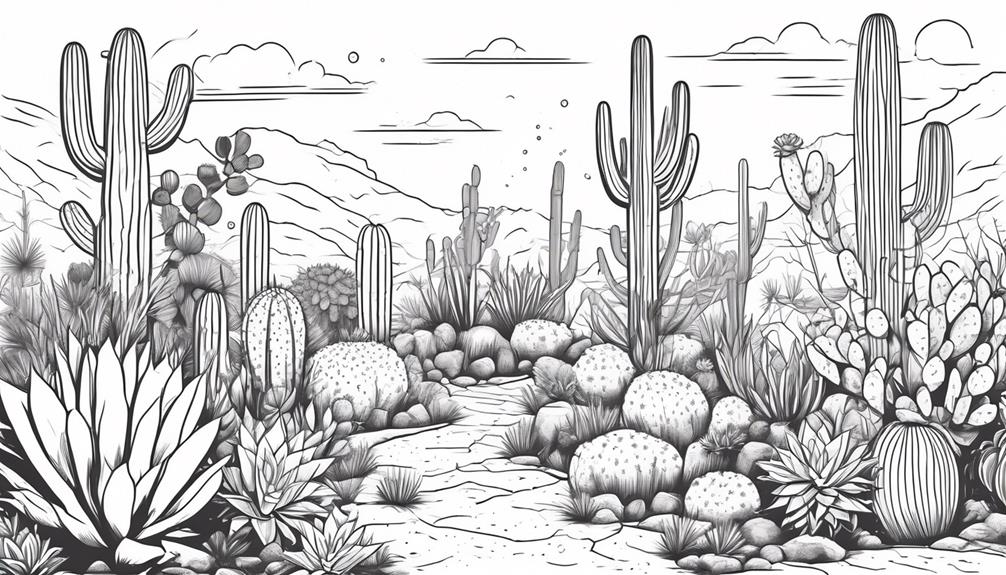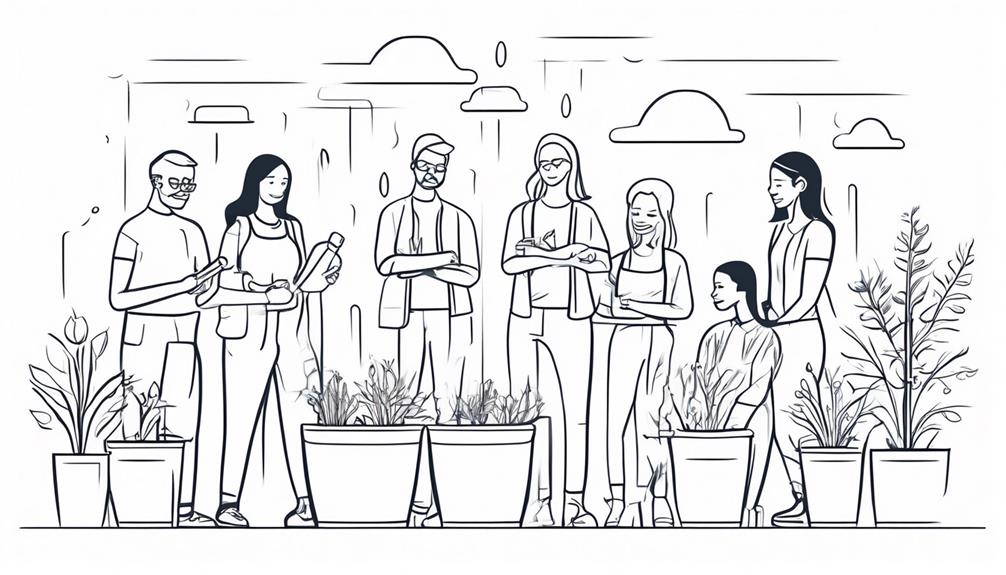Imagine your home is a ship sailing through a sea of limited water supply during a drought. As the captain of this vessel, you must navigate wisely to ensure your crew has enough water to reach their destination.
With the current drought conditions affecting many regions, it's crucial to be mindful of your water consumption. By making small yet impactful changes in your daily habits, you can steer your ship towards sustainable water conservation practices that benefit both your household and the environment.
So, how can you ensure your water usage stays afloat amidst these dry times?
Key Takeaways
- Regularly check for leaks in plumbing fixtures to prevent water wastage and address them promptly.
- Upgrade to water-efficient appliances and fixtures to reduce overall water consumption.
- Implement drought-resistant landscaping practices such as using native plants and installing drip irrigation.
- Adopt daily water conservation habits like taking shorter showers, turning off the tap when not in use, and using water wisely in household chores.
Assessing Water Usage
To accurately gauge your water usage, start by examining your daily habits and identifying areas where conservation can be improved. Begin with simple changes like turning off the tap while brushing your teeth or shaving. A running tap can waste around 6 liters of water per minute, so this small adjustment can make a significant difference. Additionally, check for any leaks in your plumbing fixtures, such as faucets and toilets, which can lead to a surprising amount of water wastage over time.
Another crucial aspect to consider is your showering routine. Showers are one of the largest sources of water usage in a household. Consider shortening your shower time by just a few minutes to save gallons of water each week. You can also install a low-flow showerhead to further reduce water consumption without sacrificing water pressure.
Fixing Leaks Promptly
When it comes to water conservation in the face of a drought, one crucial aspect is fixing leaks promptly.
You need to be proactive in identifying leaks through various detection methods and take advantage of the repair options available to you.
Leak Detection Methods
If you suspect a leak in your home, don't delay in taking action to prevent water waste and potential damage. Detecting leaks early can save you money and help conserve water.
Start by checking your water meter for any unusual fluctuations when no water is being used. Another method is to monitor your water bill for unexpected increases. Listen for the sound of running water when all fixtures are turned off, as this can indicate a hidden leak.
Inspect areas prone to leaks, such as toilets, faucets, and pipes, for any signs of moisture or dripping. Fixing leaks promptly not only saves water but also prevents costly repairs down the line.
Repair Options Available
Explore various repair options to address leaks promptly and effectively, ensuring water conservation and preventing further damage.
When dealing with leaks, start by identifying the source. For minor leaks, applying waterproof tape or sealant can provide a quick fix. If the leak is more severe, consider replacing damaged pipes or fixtures. Hiring a professional plumber may be necessary for complex issues.
Keep in mind that delaying repairs can lead to increased water wastage and potential structural damage. By acting swiftly, you not only conserve water but also save money in the long run.
Regularly checking for leaks and addressing them promptly is key to efficient water management during times of drought.
Preventing Future Leaks
To prevent future leaks and ensure water conservation, promptly fixing any identified issues is crucial to maintaining efficient water management during times of drought.
When you notice a leak, don't delay – take immediate action to address it. Check faucets, pipes, toilets, and irrigation systems regularly for any signs of leaks. Even small drips can add up to significant water wastage over time. Remember, every drop counts in times of drought.
Implementing Water-Efficient Appliances
When it comes to conserving water during a drought, one key aspect to focus on is implementing water-efficient appliances in your home.
These appliances can significantly reduce water usage without compromising on performance. Consider replacing old, water-wasting appliances with newer, energy-efficient options to make a positive impact on water conservation efforts.
Appliance Water Usage
Upgrade your appliances to water-efficient models to reduce your household's water consumption and contribute to water conservation efforts during this drought. Look for appliances with the WaterSense label, indicating they meet water efficiency and performance criteria.
Consider replacing old washing machines, dishwashers, and toilets with newer, more water-efficient models. Front-loading washing machines and dishwashers generally use less water than top-loading ones. Additionally, opt for low-flow showerheads and faucets to further decrease water wastage.
These upgrades not only help conserve water but also save you money on your water bills in the long run. Make the switch to water-efficient appliances today to make a significant impact on water conservation efforts.
Energy-Efficient Options
Consider the environmental benefits and cost savings that come with opting for energy-efficient appliances, particularly those that are water-efficient, to maximize your impact on conserving water during this drought.
Upgrading to water-efficient appliances like washing machines and dishwashers can significantly reduce water usage. Look for appliances with the ENERGY STAR label, indicating they meet high efficiency standards. These appliances not only save water but also consume less energy, lowering your utility bills.
Additionally, consider installing low-flow showerheads and faucets to further reduce water wastage. Making these simple changes can help you play a part in water conservation efforts while also cutting down on your energy costs.
Adopting Drought-Resistant Landscaping

Enhance your outdoor space with drought-resistant landscaping to save water during dry periods. When you choose plants that can thrive with minimal water, you not only conserve a precious resource but also create a beautiful and sustainable garden.
Here are some practical tips to help you get started:
- Select Native Plants: Choose plants that are indigenous to your region as they're naturally adapted to the local climate and require less water.
- Use Mulch: Mulching your garden beds helps retain moisture in the soil, reducing the need for frequent watering.
- Install Drip Irrigation: Opt for a drip irrigation system that delivers water directly to the roots of plants, minimizing water wastage through evaporation.
- Group Plants by Water Needs: Cluster plants with similar watering requirements together to ensure more efficient water usage and prevent overwatering.
Collecting Rainwater for Reuse
To further maximize your water-saving efforts in your garden, start collecting rainwater for reuse. Rainwater harvesting is a simple yet effective way to reduce your reliance on traditional water sources. You can set up a rain barrel or a more elaborate rainwater collection system to capture rain from your roof. This collected rainwater can then be used to water your plants, wash your car, or even for non-potable uses like flushing toilets.
When setting up your rainwater collection system, make sure to place it under a downspout to catch as much water as possible. Keep the system covered to prevent debris from contaminating the water. Regularly check for leaks and ensure that the collected water isn't stagnating for long periods. Remember to use the collected rainwater promptly to make room for more during the next rainfall.
Educating on Water-Saving Practices

Encouraging individuals to adopt water-saving practices can significantly contribute to conserving this precious resource amidst drought conditions. Here are four simple yet effective ways to educate yourself and others on water-saving practices:
- Fix Leaks Promptly: Regularly check for leaks in faucets, toilets, and pipes. A small leak may not seem significant, but it can waste a surprising amount of water over time.
- Shorten Shower Time: Consider taking shorter showers. Even reducing your shower time by a few minutes can lead to significant water savings in the long run.
- Use a Dishwasher Efficiently: Wait until you have a full load before running the dishwasher. Also, consider scraping dishes instead of rinsing them before loading them into the dishwasher to save water.
- Water Plants Wisely: Water your plants in the early morning or late evening to reduce evaporation. Also, consider using a soaker hose or drip irrigation system to deliver water directly to the roots where it's needed most.
Frequently Asked Questions
How Can I Effectively Monitor My Water Usage on a Daily Basis?
To effectively monitor your water usage daily, start by checking all faucets and appliances for leaks. Track your consumption with a water meter. Implement small changes like shorter showers and turning off the tap while brushing to conserve water.
Are There Any Common Household Items That Can Contribute to Water Wastage That I May Not Be Aware Of?
You might not realize that leaky faucets, running toilets, and old showerheads can silently waste water. Check for these culprits and fix them promptly to prevent unnecessary water wastage in your household.
What Are Some Innovative Ways to Reuse Greywater in My Home to Reduce Water Consumption?
To reduce water consumption at home, consider using greywater creatively. Repurpose it for flushing toilets, watering plants, or cleaning. Innovate with DIY systems or professional setups to make the most of this resource.
How Can I Encourage My Community to Adopt Water-Saving Practices and Contribute to Water Conservation Efforts?
To encourage your community to save water, lead by example. Share easy tips like fixing leaks, using efficient appliances, and watering plants wisely. Organize events, workshops, or challenges to raise awareness and inspire positive change.
Are There Any Government Incentives or Programs Available to Help Offset the Costs of Installing Water-Efficient Appliances or Implementing Drought-Resistant Landscaping?
Like a helping hand in a storm, government incentives and programs exist to ease the burden of adopting water-efficient appliances and drought-resistant landscaping. They can offset costs, making conservation efforts more accessible.
Conclusion
By assessing your water usage, fixing leaks promptly, implementing water-efficient appliances, adopting drought-resistant landscaping, collecting rainwater for reuse, and educating on water-saving practices, you can make a big impact on water conservation during a drought.
With these practical tips, you can see a lush garden thriving alongside a dry desert, representing the balance between water conservation efforts and the challenges of a changing climate.
Start making a difference today!
